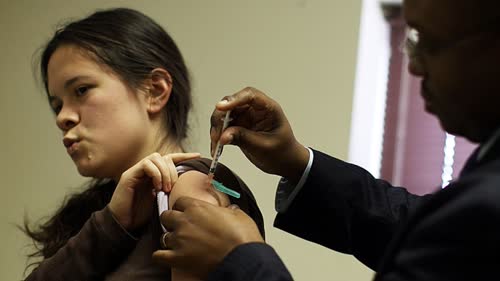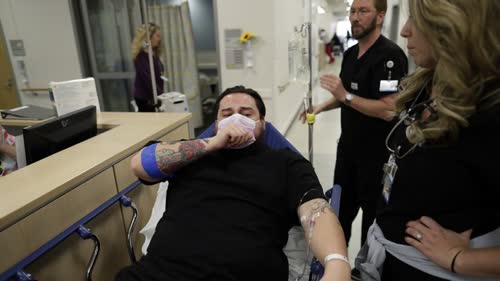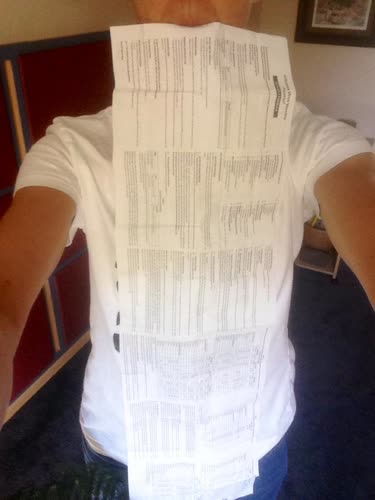|
Vaccines role in causing autoimmune disease These reports focus on the occurrence of neurological manifestations (GuillainBarre syndrome, multiple sclerosis, autism), joint manifestations (arthritis, rheumatoid arthritis), and other autoimmune phenomena (systemic lupus erythematosus, diabetes mellitus) following various vaccines administered either alone or in combination [reviewed in (1, 2)]. Even though Guillain-Barre syndrome has been reported following various vaccines, including rabies, tetanus toxoid, smallpox, mumps, rubella, hepatitis B, poliovirus and diphtheria (3, 4), its strongest association is with the influenza vaccine. A slight increase of one to two additional Guillain-Barre syndrome cases per million vaccinated persons has been reported following an influenza vaccination program in 1992- 1993 (5). Similarly, multiple sclerosis has been reported mostly in association with hepatitis B vaccine (6). Systemic lupus erythematosus (SLE) was also primarily associated with hepatitis B vaccine (7); however, lupus vulgaris was reported following BCG vaccine (8). Diabetes mellitus, on the other hand, has been connected most specifically to the vaccination for Haemophilus influenza type b (1, 2). |
|
Selenium Deficiency Causes Flu Virus To Mutate Into More Dangerous Forms Influenza virus that has been passed through mice deficient in the trace nutrient selenium mutates and emerges from the mice more virulent than before, a new study shows. |
|
In 1976 flu killed one while the flu shot killed 32 In 1976, 2 recruits at Fort Dix, New Jersey, had an influenzalike illness. Isolates of virus taken from them included A/New Jersey/76 (Hsw1n1), a strain similar to the virus believed at the time to be the cause of the 1918 pandemic, commonly known as swine flu. Serologic studies at Fort Dix suggested that >200 soldiers had been infected and that person-to-person transmission had occurred. We review the process by which these events led to the public health decision to mass-vaccinate the American public against the virus and the subsequent events that led to the program's cancellation. Observations of policy and implementation success and failures are presented that could help guide decisions regarding avian influenza. |
|
"...influenza mortality and hospitalization rates for older Americans significantly increased in the 80's and 90's, during the same time that influenza vaccination rates for elderly Americans dramatically increased. Even when aging of the population is accounted for, death rates of the most immunized age group did not decline." Published: 25 February 2008 |
|
Guillain-Barré syndrome after vaccination in United States Death and disability after the event occurred in 32 (3.2%) and 167 (16.7%) subjects, respectively. The highest number (n = 632) of GBS cases was observed in subjects receiving influenza vaccine followed by hepatitis B vaccine (n = 94). Other vaccines or combinations of vaccines were associated with 274 cases of GBS. |
|
System backfired. Some adult victims of severe H1N1 had lungs full of a protein called C4d (orange, left). C4d usually helps destroy viruses, but researchers think that when it met the 2009 virus, it helped kill the host instead. How Swine Flu Killed the Healthy |
|
Severe pandemic 2009 H1N1 influenza disease due to pathogenic immune complexes Pandemic influenza viruses often cause severe disease in middle-aged adults without preexisting comorbidities. The mechanism of illness associated with severe disease in this age group is not well understood1,2,3,4,5,6,7,8,9,10. Here we find preexisting serum antibodies that cross-react with, but do not protect against, 2009 H1N1 influenza virus in middle-aged adults. Nonprotective antibody is associated with immune complex–mediated disease after infection. We detected high titers of serum antibody of low avidity for H1-2009 antigen, and low-avidity pulmonary immune complexes against the same protein, in severely ill individuals. Moreover, C4d deposition—a marker of complement activation mediated by immune complexes—was present in lung sections of fatal cases. Archived lung sections from middle-aged adults with confirmed fatal influenza 1957 H2N2 infection revealed a similar mechanism of illness. These observations provide a previously unknown biological mechanism for the unusual age distribution of severe cases during influenza pandemics. |
|
Annual Vaccination against Influenza Virus Hampers Development of Virus-Specific CD8+ T Cell Immunity in Children Infection with seasonal influenza A viruses induces immunity to potentially pandemic influenza A viruses of other subtypes (heterosubtypic immunity). We recently demonstrated that vaccination against seasonal influenza prevented the induction of heterosubtypic immunity against influenza A/H5N1 virus induced by infection with seasonal influenza in animal models, which correlated with the absence of virus-specific CD8+ T cell responses. Annual vaccination of all healthy children against influenza has been recommended, but the impact of vaccination on the development of the virus-specific CD8+ T cell immunity in children is currently unknown. Here we compared the virus-specific CD8+ T cell immunity in children vaccinated annually with that in unvaccinated children. In the present study, we compared influenza A virus-specific cellular and humoral responses of unvaccinated healthy control children with those of children with cystic fibrosis (CF) who were vaccinated annually. Similar virus-specific CD4+ T cell and antibody responses were observed, while an age-dependent increase of the virus-specific CD8+ T cell response that was absent in vaccinated CF children was observed in unvaccinated healthy control children. Our results indicate that annual influenza vaccination is effective against seasonal influenza but hampers the development of virus-specific CD8+ T cell responses. The consequences of these findings are discussed in the light of the development of protective immunity to seasonal and future pandemic influenza viruses. |
|
Stroke and influenza vaccination: a case report We report a 75-year-old male patient who suffered posterior circulation ischaemia after influenza A/H1N1 vaccination. Vaccination provokes a variable magnitude of inflammatory and immunological response that modifies the risk for ischaemic stroke. Whereas a causal relation between vaccination and ischaemic stroke is still unsettled, an inflammatory/immunological response after vaccination may trigger thrombosis superimposing a pre-existing prothrombotic state. Careful monitoring is strongly suggested for individuals who received H1N1 vaccine, especially those with high ischaemic stroke risk. |
|
Increased risk of noninfluenza respiratory virus infections associated with receipt of inactivated influenza vaccine. We randomized 115 children to trivalent inactivated influenza vaccine (TIV) or placebo. Over the following 9 months, TIV recipients had an increased risk of virologically-confirmed non-influenza infections (relative risk: 4.40; 95% confidence interval: 1.31-14.8). Being protected against influenza, TIV recipients may lack temporary non-specific immunity that protected against other respiratory viruses. |
|
Flu shot linked to higher incidence of flu in pandemic year Canadian researchers noticed in the early weeks of the pandemic that people who got a flu shot for the 2008-2009 winter seemed to be more likely to get infected with the pandemic virus than people who hadn't received a flu shot.
|
|
Giant cell arteritis and polymyalgia rheumatica after influenza vaccination Giant cell arteritis (GCA) and polymyalgia rheumatica (PMR) are inflammatory rheumatic diseases common in people over the age of 50 years. Herein, we report 10 cases of previously healthy subjects who developed GCA/PMR within 3 months of influenza vaccination (Inf-V). A Medline search uncovered additional 11 isolated cases of GCA/PMR occurring after Inf-V. We discuss the role of individual susceptibility, the potential function of immune adjuvants as triggers of autoimmunity post-vaccination, and the correlation of our observation with the 'ASIA' syndrome, i.e. autoimmune/inflammatory syndrome induced by adjuvants and including post-vaccination phenomena. |
|
Childhood Stroke after Influenza Vaccination Neurological complications following influenza vaccination are rare in children, with the most common being seizures, and less commonly encephalopathy and Guillain-Barré syndrome. We report here a 10-yearold child who developed cerebellar stroke one day after receiving the seasonal trivalent influenza vaccine; to our knowledge this is the first reported case in literature. The child presented with acute-onset vertiginous giddiness, blurred vision, headache and non-bilious vomiting. Clinical examination revealed marked ataxia with past pointing worse on the right. Laboratory investigations did not reveal any thrombophilic tendency and there was no suggestion of embolic phenomena from a distant site. Magnetic resonance imaging (MRI) of the brain showed two areas of restricted diffusion in the left cerebellar hemisphere. She was commenced on aspirin and underwent rehabilitation before being discharged six days after admission in good health. She recovered completely by outpatient review and aspirin was discontinued eight months after presentation. |
|
Influenza vaccine-induced interstitial lung disease A 75-yr-old female was referred to our hospital (Komatsu Municipal Hospital, Komatsu, Japan) for evaluation of fever and chest radiograph abnormalities in November 2011. 2 weeks previously she had received the influenza vaccine (trivalent inactivated vaccine: A/California/7/2009 [H1N1]-like, A/Victoria/210/2009 [H3N2]-like, and B/Brisbane/60/2008-like antigens). She had developed a fever 1 week before admission, and a chest radiograph revealed patchy airspace infiltrates in both lungs (fig. 1a). She received garenoxacin without any improvement and was then referred to our hospital for further evaluation. She had a medical history of hypertension, anaemia and chronic renal failure due to diabetes, and had started regular haemodialysis at the age of 74 yrs. She had no past history of pulmonary disease and her chest radiograph the previous month was normal. Her medications included valsartan, furosemide, isosorbide dinitrate and cilnidipine, which had remained unchanged for 2 yrs. She also had an insulin injection every day. She was a nonsmoker and had no allergies to foods or drugs |
|
"... seasonal flu vaccination almost doubled the risk of infection with pandemic flu."
'Canadian problem' an example of odd effects of prior vaccination |
|
Public Health Officials Know: Recently Vaccinated Individuals Spread Disease For example, the Johns Hopkins Patient Guide warns the immunocompromised to "Avoid contact with children who are recently vaccinated," and to "Tell friends and family who are sick, or have recently had a live vaccine (such as chicken pox, measles, rubella, intranasal influenza, polio or smallpox) not to visit." |
|
Immunization selects for the most pathogenic forms of a virus. Abstract Could some vaccines drive the evolution of more virulent pathogens? Conventional wisdom is that natural selection will remove highly lethal pathogens if host death greatly reduces transmission. Vaccines that keep hosts alive but still allow transmission could thus allow very virulent strains to circulate in a population. Here we show experimentally that immunization of chickens against Marek's disease virus enhances the fitness of more virulent strains, making it possible for hyperpathogenic strains to transmit. |
|
Primary vaccine failure to routine vaccines: Why and what to do? There are 2 major factors responsible for vaccine failures, the first is vaccine-related such as failures in vaccine attenuation, vaccination regimes or administration. The other is host-related, of which host genetics, immune status, age, health or nutritional status can be associated with primary or secondary vaccine failures. |
|
Association of spontaneous abortion with receipt of inactivated influenza vaccine SAB was associated with influenza vaccination in the preceding 28 days. The association was significant only among women vaccinated in the previous influenza season with pH1N1-containing vaccine. This study does not and cannot establish a causal relationship between repeated influenza vaccination and SAB, but further research is warranted. |
|
Multiply vaccinated subjects were actually more likely to develop influenza than unvaccinated subjects "In one year of the study, it appeared that multiply vaccinated subjects were actually more likely to develop influenza than unvaccinated subjects"
|
|
"Influenza vaccines seem to be modifying influenza into a dangerous dengue-like disease" Last year's influenza vaccine also contained the same H3N2 strain as this year's vaccine (A/Hong Kong/4801/2014 (H3N2)-like virus). Many people would have developed long term IgE mediated sensitization to the H3N2 viral proteins due to last year's vaccine [1–4]. Those who received the Flublok vaccine can be expected to have an even stronger IgE response due to its 3X viral protein content [5,4]. This year's vaccine H3N2 proteins would have been neutralized by these IgE antibodies. Thus resulting in the observed low vaccine efficacy. [6]
|
|
The Perfect Storm Behind This Year's Nasty Flu Season - A strong virus, a less-than-effective vaccine, and an IV bag shortage that goes back to Hurricane Maria. According to the numbers, this year’s flu season is in fact worse than usual. It got started early, and it’s been more severe. Twenty kids have died of the flu since October. And in the week ending January 6, 22.7 out of every 100,000 hospitalizations in the U.S. were for flu—twice the number of the previous week. |
|
"The vaccine for 2018-19 contains two critical mutations that arise from the egg-based vaccine production process, these mutations halved the efficacy of flu vaccines in the past two seasons, and we expect they will lower the efficacy of the next vaccine in a similar manner." A Rice University study predicts that this fall's flu vaccine -- a new H3N2 formulation for the first time since 2015 -- will likely have the same reduced efficacy against the dominant circulating strain of influenza A as the vaccine given in 2016 and 2017 due to viral mutations related to vaccine production in eggs. |
|
vaccination was associated with higher viral shedding; vaccination with both seasonal vaccines, was associated with greater shedding Self-reported vaccination for the current season was associated with a trend (P < 0.10) toward higher viral shedding in fine-aerosol samples; vaccination with both the current and previous year’s seasonal vaccines, however, was significantly associated with greater fine-aerosol shedding in unadjusted and adjusted models (P < 0.01). In adjusted models, we observed 6.3 (95% CI 1.9–21.5) times more aerosol shedding among cases with vaccination in the current and previous season compared with having no vaccination in those two seasons. Vaccination was not associated with coarse-aerosol or NP shedding (P > 0.10). The association of vaccination and shedding was significant for influenza A (P = 0.03) but not for influenza B (P = 0.83) infections (Table S4). |
|
Settlement reached in swine flu vaccine case Summary: A girl proved in court she got Narcolepsy, which is ai immune disorder, from a flu shot which damaged her immune system. The court agreed and ordered the state to pay
|
|
Flu shots increased the rate of death from flu in vaccinated persons, the expected decline in flu deaths did not materialize. Original Investigation
February 14, 2005 "we conclude that observational studies substantially overestimate vaccination benefit." "Observational studies report that influenza vaccination reduces winter mortality risk from any cause by 50% among the elderly. Influenza vaccination coverage among elderly persons (≥65 years) in the United States increased from between 15% and 20% before 1980 to 65% in 2001. Unexpectedly, estimates of influenza-related mortality in this age group also increased during this period. We tried to reconcile these conflicting findings by adjusting excess mortality estimates for aging and increased circulation of influenza A(H3N2) viruses." |
|
Contraindications and side effects 1. The single dose vial contains mercury at ≤1mcg (This is called a "trace amount" by the industry.) The multi-vial contains 25 mcg. |
|
Does the flu shot really matter? The flu shot's dirty little secret. The Atlantic, November 2009.
|
|
FluMist is a disaster June, 2016 8 year old girl dies of flu after immunization with FluMist nasal flu vaccine. |
|
Inactivated influenza vaccine given alone was most commonly associated with death reports in adults (51.4%). Deaths Reported to the Vaccine Adverse Event Reporting System, United States, 1997–2013 |



